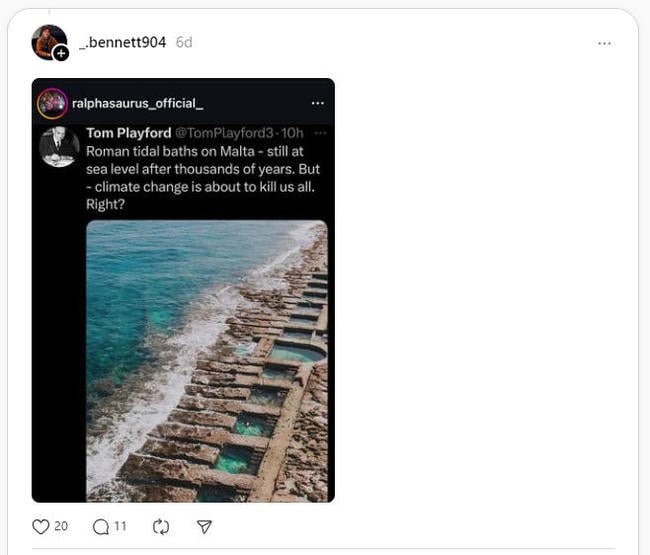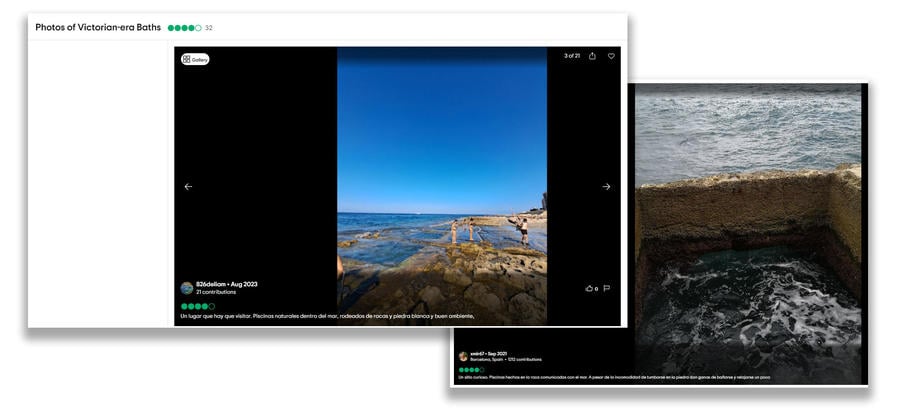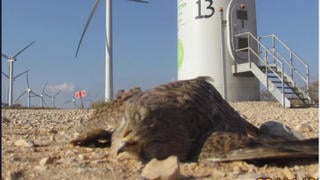
Does a photo of the "Roman tidal baths" on Malta demonstrate that the sea level has been consistent for thousands of years? No, that's not true: The waterfront architecture known as the Roman Baths of Sliema were not built during the Roman Empire thousands of years ago, but some time in the late 19th century -- so their seaside existence and one photo of the Victorian-era attraction on a tidal coast does not prove anything about thousand-year sea level trends, or provide a baseline from the Roman Era. A paper published by scientists from the UK-based National Oceanography Centre in 2022 reported that the Mediterranean Sea rose about 7 centimeters between 2000 and 2018, which was a sharp increase from previous decades.
The claim appeared in a post (archived here) where it was published on Threads on July 2, 2024. Text in the posted screenshot reads:
ralphasaurus_official_
Tom Playford @TomPlayford3-10h
Roman tidal baths on Malta - still at sea level after thousands of years. But climate change is about to kill us all. Right?
This is how the post appeared on Threads at the time of writing:
(Image source: Threads screenshot taken on Mon Jul 08 17:54:04 2024 UTC)
The photo appearing in the meme appeared in a March 22, 2019, post on Instagram by a travel blogger from Finland, @julia_kivela. The post was captioned:
Amazing pools in Sliema. Try to spot me 😄
The history of these pools carved in the rocks of the Sliema coastline is not well-documented but it is understood that they are not as old as the Roman Empire. Tourism articles refrain from placing a definitive date on when they were constructed, and use phrases like, "even if these probably date back to the 19th or early 20th centuries" and, "Instead, they appear to have their origins in the late 19th century, when Malta was a colony of the United Kingdom." They were built to afford bathers a sheltered and safer pool of sea water without the challenges of swimming in the surf near a rock shelf that drops off steeply from the shore. There are still visible holes adjacent to the pools for wooden poles from which canopies for sunshade and privacy could be suspended.
A gallery of 21 photos of the "Victorian-era Baths" is hosted on tripadvisor.com. Pictured below left is slide #3, showing the flat and sloping stone surface where the pools are carved -- slightly submerged by the Mediterranean sea. Other photos (below right slide #8) show the level of the sea much lower with the vertical walls of the pools and the shoreline rock exposed and dry. The waves at this point on the island of Malta are breakers, but the tides in Sliema are modest. At the time of writing, the difference between high and low tide is less than eight inches. A single photo does not serve as evidence of changes or lack thereof in sea level over thousands of years.
(Image source: tripadvisor.com screenshot taken on Mon Jul 08 18:58:02 2024 UTC)
The National Oceanography Centre (NOC) published an article on October 31, 2022, announcing the publication of a study in the Journal of Geophysical Research titled, "The Sources of Sea-Level Changes in the Mediterranean Sea Since 1960." Summarizing:
The study revealed that sea level in the Mediterranean Sea increased by about 7cm in the period 2000-2018.
The abstract of the study concludes:
After 1989, Mediterranean sea level started accelerating rapidly, driven by both sterodynamic changes and land-ice loss, reaching an average rate of 3.6 ± 0.3 mm yr−1 in the period 2000-2018. The rate of sea-level rise shows considerable spatial variation in the Mediterranean Sea, primarily reflecting changes in the large-scale circulation of the basin. Since 2000, sea level has been rising faster in the Adriatic, Aegean, and Levantine Seas than anywhere else in the Mediterranean Sea.
Lead Stories reached out to The National Oceanography Centre and will update this article if we receive a reply.
Other fact check agencies have also reviewed this claim, including Snopes, CheckYourFact and Politifact.
Additional Lead Stories fact checks on claims about sea level changes can be found here.

















